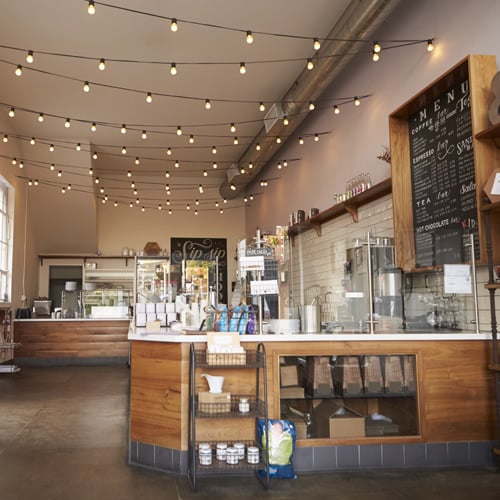
The coffee industry continues expanding as younger generations show a growing interest in high-quality gourmet coffee, freshly roasted beans, and supporting local artisan coffee shops. With the rising popularity of coffee, now is an ideal time to explore the possibility of opening a coffee shop or cafe. If you're considering starting a coffee shop but are unsure where to start, use our guidelines and tips to establish your business successfully.
Shop All Coffee Supplies- Choose a Coffee Shop Concept
- Write a Coffee Shop Business Plan
- Obtain Funding for Your Coffee Shop Business
- Select a Coffee Shop Location
- File for Coffee Shop Licenses and Permits
- Design a Coffee Shop Layout
- Order Coffee Shop Equipment and Supplies
- Hire Baristas and Staff for Your Coffee Shop
- Advertise Your Coffee Shop
- Host a Coffee Shop Soft Opening
1. Choose a Coffee Shop Concept

Once you've decided to start a coffee shop, choose your coffee shop's concept. Your concept is the brand identity of your cafe, and a good concept will give your business a competitive edge over other coffee shops in the area. Consider your shop's name, menu, coffee beans, service style, decor, and type of business model.
- Franchise: Joining a coffee shop franchise provides you with a proven business model, established brand recognition, and support from the franchisor. Though you have less independence in overall operations, it gives you a structured approach to managing the business.
- Standalone business: If you want total creative freedom, an independent coffee shop is your ideal business model. It appeals to local customers, allowing you to create a unique brand identity and build customer loyalty.
- Mobile business: Coffee trucks and carts offer flexibility and unique opportunities to owners looking to differentiate themselves from local competitors. This mobile model allows you to target different demographics, locations, and events for more potential gain.
- Catering: If you want to target events, parties, and corporate functions, consider a coffee catering service. You can customize your offerings to the event type, providing creative challenges if you enjoy new experiences.
Conduct Research on the Area and Target Demographics
Before determining what concept works best for your coffee shop, research the local competition and your future customers' preferences. Study established cafes with a loyal customer base to determine what makes them successful, then replicate those traits where applicable. However, you should also use these details to differentiate yourself from them. An identical concept is unlikely to attract new customers from the existing businesses.
Examine the following areas during the research stage to shape your coffee shop concept:
- Target demographic: Your potential customers' primary generations, occupations, and values will impact your concept. Gen Z-ers working virtually might prefer gourmet coffee with plenty of seating and fast WiFi, while an area with many offices might require emphasis on quick service and simple offerings.
- Pricing: You may be passionate about opening a gourmet cafe, but it may be hard to convince customers to pay $6 for coffee in a primarily working-class neighborhood.
- Food: If you want to add food to your menu, decide whether to outsource it or make all the food in-house. While cost is a significant factor in this decision, think about your potential customers' preferences as well.
- Sit-down vs to-go: Busy areas might prefer robust to-go stations with mobile ordering, while university towns and remote working hubs lean toward sit-down establishments.
2. Write a Coffee Shop Business Plan

A solid business plan is necessary for any type of foodservice operation to succeed. Your business plan will be instrumental in refining your coffee shop concept, planning your ownership structure, projecting your finances, developing your menu, and documenting your competitive research findings. Investing time in this aspect of your business will facilitate securing funding and making informed decisions before opening your doors.
There are eight sections in a standard business plan:
- Executive Summary: A concise overview of your coffee shop, highlighting your mission statement, objectives, and key points.
- Company Overview and Description: Detailed information about your coffee shop, including its legal structure, location, and ownership.
- Concept and Menu: A description of your product offerings, including coffee varieties, beverages, food items, and any unique selling propositions.
- Management and Ownership Structure: An outline of your business’s organizational structure, detailing key roles and responsibilities.
- Employees and Staffing Needs: An overview of staffing requirements, such as managers, baristas, kitchen staff, and servers.
- Marketing and Competitor Analysis: An analysis of your target market, including demographics, preferences, and purchasing behaviors.
- Advertising and Marketing Strategies: A plan for promoting your coffee shop through both online and offline marketing tactics.
- Financial Projection and Summary: Detailed financial forecasts for your coffee shop, including sales projections, expenses, and profit margins.
3. Obtain Funding for Your Coffee Shop Business
Since starting a coffee shop is expensive, the next step is to get startup capital for your new coffee shop. Costs range from equipment and supplies to furniture to initial payroll. It typically takes a new operation 6-12 months to become profitable, so your funding should be able to cover operating costs until your business can support itself.
There are a few different paths you can take to get funding for your coffee shop:
- Small business loan: A loan offered by financial institutions or online lenders specifically made for entrepreneurs starting or expanding their businesses.
- Traditional commercial loan: A lump-sum loan offered by traditional banks or credit unions with a fixed interest rate and repayment terms.
- Business line of credit: A flexible financial stream that allows owners to borrow funds as required.
- Crowdfunding: An online fundraising method by pitching your business to large groups of investors on specific platforms.
How Much Does It Cost to Open a Coffee Shop?
The total price of opening a coffee shop will depend on several factors, but your location is the most important consideration. It can cost anywhere from around $100k to over $600k to open a coffee shop, depending on the size and location of your operation.
4. Select a Coffee Shop Location

Finding the best commercial space for your cafe is essential, and a good location encourages a steady flow of customers to your business. Check the kitchen for space and the necessary equipment hookups, then examine the main area to ensure it has enough space and the right aesthetic for your target customers. If the building requires extensive renovation to match your brand, look elsewhere or pivot your brand.
When looking at potential spaces, be sure to complete a location analysis. It takes many things into account, such as:
- Demographics
- Proximity to your target demographic
- Foot traffic, parking, and visibility
- Distance from suppliers
- Competition
- Crime rates
- Regulations and zoning
Once you find the perfect location, we suggest hiring a lawyer to help with negotiations and complete all the necessary paperwork and regulations.
5. File for Coffee Shop Licenses and Permits
If you want to sell to the public, states and cities require specific permits and licenses to operate. These items vary by location, so check with your local government to ensure you have all the necessary paperwork. Waiting for approval will take time, so plan ahead to give yourself ample wait time before opening day.
Below, we list some common permits and licenses for coffee shops. Check your local requirements for specifics on these items.
- Business license
- Employee Identification Number (EIN)
- Foodservice license
- Building permit
- Food handler's permit
6. Design a Coffee Shop Layout
Creating an optimal design for your coffee shop interior is essential for efficiency and your customers' comfort. Each area requires different considerations, so view the spaces through the eyes of those using them to create the best layout.
Designing the Front-of-House Layout

When designing your front-of-house area, consider the atmosphere you want to create for your core customers. Open, airy concepts are ideal for meeting up with friends, but privacy is a necessity for customers working from your shop. Some types of customers prefer tables, while others enjoy lounging on an overstuffed chair. Consider the size of your space and how you can maximize your seating.
Choose the furniture color and style carefully. Dark colors will make the space feel more intimate, lighter colors feel more inviting, and bright colors increase customers' appetites. The furniture should match the aesthetic you're trying to achieve.
Designing the Back-of-House Layout
The area behind the counter at coffee shops tends to be crowded, making efficiency and workflow crucial. When designing your back-of-house, consider the stations and how orders will flow. This process will start with taking the order, then preparation, service, and cleaning the equipment. Additionally, food equipment needs to fit in your layout if your coffee shop serves food.
Back to Top7. Order Your Coffee Shop Equipment

High-quality coffee equipment is essential for any cafe or coffee shop that wants to succeed. While some machines may vary from shop to shop, there are a few items that every cafe will need. We put together a list of essential coffee shop equipment to help you remember what you need when starting your cafe.
Equipment
No matter your menu, the following equipment items are necessities for every coffee shop.
- Coffee brewers
- Airpots
- Espresso machine
- Coffee grinder
- Coffee roaster
- Hot water dispenser
- Reach-in refrigerator
- Ice machine
- Compartment sink
Supplies
Provide your baristas with coffee-making supplies to help them make delicious coffee drinks.
- Frothing pitchers
- Frothing thermometers
- Mugs and cups
- Espresso tampers
- Cup, lid, and straw organizers
- Measuring cups and spoons
- Storage containers
- Knock boxes
- Syrup pumps
- Coffee filters
Coffee Beans
Serving high-quality coffee is paramount to running a coffee shop and defines your brand. Many coffee shops purchase their coffee beans wholesale from a coffee roaster, though some look for independent sources. Be specific when looking for a roaster to source your coffee beans, and consider the following factors:
- Taste: If you don't like the roaster's coffee, then chances are your customers won't either.
- Quality: High-quality beans can be expensive, resulting in higher drink prices that may scare away some potential customers.
- Location: Buying from a roaster in your area is a great way to interest customers while also supporting a local business. Plus, a local roaster may have brand recognition in your area that one farther away may not.
- Ethical sourcing: Fairtrade coffee promotes the ethical pay and treatment of coffee producers, and it's a fast-growing movement. Likewise, single origin coffee comes from one distinct location, making them easy to trace to the grower.
- Flavors: Make sure the coffee roaster has the types of coffee that you want to serve.
Consumables
Beyond simple black coffee, the following flavors and additives will enhance your drinks and build your brand.
- Flavoring syrups
- Tea
- Hot chocolate
- Milk and milk alternatives
- Chai
- Creamer
- Sugar and sweeteners
Disposables
If you serve coffee to go, make sure you have the following disposables.
- Napkins
- To-go cups, lids, and straws
- Cup sleeves
- Cup carriers
8. Hire Baristas and Staff for Your Coffee Shop
Excellent customer service is vital for the success of your new cafe, so be selective when hiring staff. Additionally, consider what level of experience you want job applicants to have. Hiring experienced baristas might cost more, but it allows you to manage other areas while they train new staff.
Anyone tasked with training employees should know how to create every beverage on your menu and the flavor profiles of your chosen coffee beans. Some customers may be interested in learning more about your coffee selection, and your staff should be able to answer their questions and make suggestions. Consider bringing in an outside professional to train your employees on the finer points of coffee and brewing.
9. Advertise Your Coffee Shop

Advertising is crucial to ensuring you begin turning a profit as quickly as possible. By incorporating a combination of traditional and digital marketing techniques, you can engage and retain customers. Consider the following approaches to elevate your brand awareness:
- Conventional marketing: Explore traditional marketing avenues like printed ads, flyers, and direct mail campaigns to connect with a broader audience. Collaborate with local businesses, explore sponsorships, and participate in community events to enhance your brand's visibility.
- Social media engagement: Leverage the power of social media platforms to promote your coffee shop in today's digital landscape. Create compelling content on platforms like Instagram, Facebook, and Twitter to showcase your offerings, engage with customers, and foster a loyal following. Utilize targeted advertising tools to reach potential patrons in your vicinity.
- Online presence: Enhance your digital footprint by developing a professional website that features your menu, location details, and contact information. Employ search engine optimization (SEO) strategies to boost your website's visibility in online searches. List your business on online directories and review platforms like Google My Business, Yelp, or Tripadvisor to attract a broader audience.
- Customer loyalty programs: Implementing a customer loyalty program can help retain current customers and attract new ones. Provide rewards like discounts, complimentary beverages, or exclusive promotions to encourage repeat business and cultivate customer loyalty.
- Word-of-mouth: Word-of-mouth marketing continues to be a potent tool for customer acquisition. Encourage satisfied customers to spread the word about your coffee shop through referral incentives or by hosting events that encourage social sharing.
10. Host a Coffee Shop Soft Opening

A soft opening event is the perfect opportunity to troubleshoot your operation, attract core customers, and generate buzz. You can oversee various processes to monitor order flow, equipment functionality, staff preparedness, and your front-of-house comfort. Keep these things in mind when hosting a soft opening for your coffee shop:
- Offer discounts or promotions: Free or discounted products incentivize new customers to try a new coffee shop rather than returning to their favorite haunt.
- Create a guest list: Send out invitations to specific clientele - such as local influencers and non-adjacent business owners - to create a sense of exclusivity and generate buzz.
- Collect feedback: Ask your customers for their thoughts on the menu, quality, prices, wait times, and atmosphere. This feedback will help you troubleshoot areas before the grand opening.
Now is the ideal time to take the leap and open a coffee shop or cafe, especially as the coffee industry continues to surge. While the process may seem intimidating, organization and determination can carry you to opening day. Follow your business plan diligently to establish your business and set yourself up for success.





